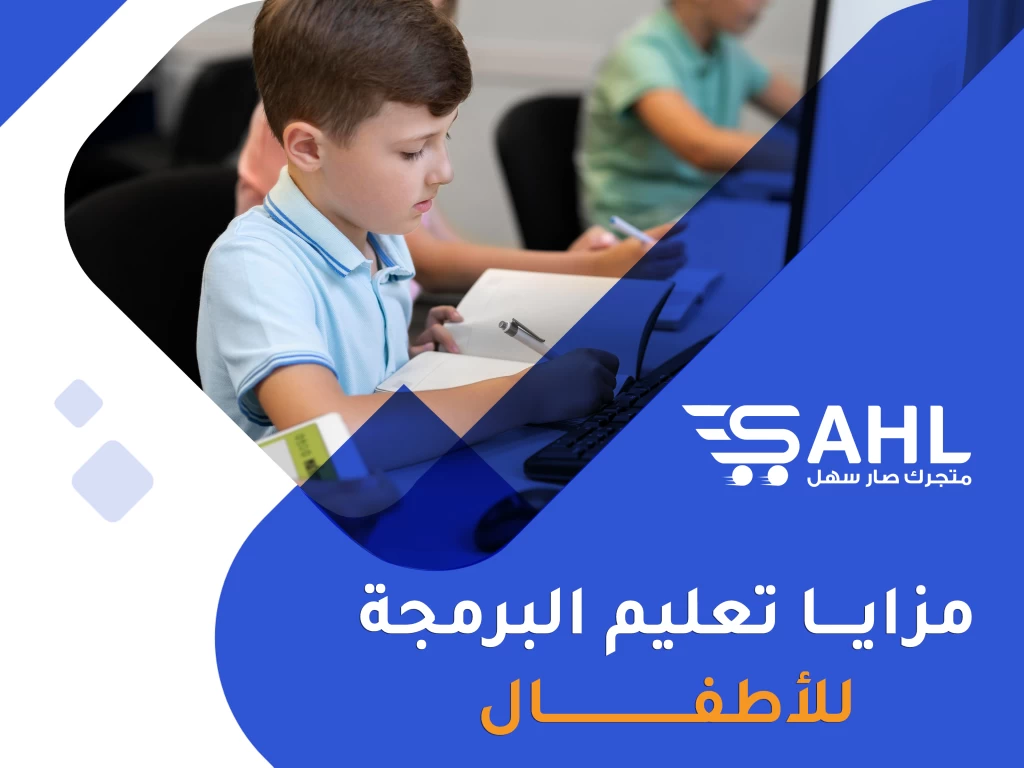Free support 24/7
Free support 24/7

Our current era lives in light of the development of technology and rapid digital transformation, as programming skills have become an indispensable necessity for success in various areas of life. Hence, the importance of teaching programming to children from an early age, as this skill can have a significant impact on their mental and social development. In this article, we will go over the advantages of teaching kids coding and some of our favorite ways to teach it.
Advantages of teaching programming to children
1. Developing the skills of the analytical mind and critical thinking
Learning to code encourages children to develop analytical mind and critical thinking skills. When children learn how to write code and solve programming problems, they learn how to break down problems into small parts and then solve them step by step, which contributes to the development of their mental abilities.
2. Fostering creativity and innovation
Coding enables children to express their ideas and bring them to reality by creating apps or games. This encourages the development of creativity and innovation and gives children the opportunity to discover their different creative abilities.
3. Learn future life skills
Programming skills are not only important for the areas of information technology, but rather life skills that can benefit children in various areas of their future lives. Learning to code teaches them flexibility, problem-solving, critical thinking, and teamwork, and these skills are valuable in any path they choose.
4. Boost self-confidence
When children learn to build small applications or solve software problems, they feel clear progress and it increases their self-confidence. The experience of the challenge and success in programming something enhances their spirit of positivity and confidence.
5. Enhance problem-solving skills
Teaching programming encourages children to develop problem-solving skills, as they learn how to break down a big problem into smaller parts, tackle each part separately, and then combine solutions to reach the end goal.
6. Enhancing cooperation and teamwork skills
Learning to code can sometimes involve teamwork on a software project. This encourages children to cooperate with their peers, share ideas, and provide assistance to each other, which enhances communication and teamwork skills.
7. Develop systems thinking
When children learn to code, they must follow a specific sequence of steps to arrive at a solution. This contributes to the development of systemic thinking and the ability to plan and organize, important skills in their lives.
8. Expanding future professional horizons
With the increasing reliance on technology in various fields, programming skills open wide doors of career opportunities for children as they grow up. Whether they are interested in application development, information security, web design, or even artificial intelligence.
9. Promote creative thinking and design
Learning to code encourages children to develop creative thinking and their ability to design and develop their own ideas. They can create unique apps and games that express their interests and vision.
10. Promote motivation and perseverance
The programming process may confront children with challenges and difficulties. By overcoming these challenges, they gain perseverance and motivation, as they realize the importance of continuing to try until they achieve their desired goal.
11. Develop coding and English language skills
Learning to program involves understanding and writing code. This enhances children's coding and English language skills, as they learn new terms and grammar that will benefit them in various areas of their lives.
12. Promote scientific and analytical thinking
Learning to code encourages children to think scientifically and analytically, as they learn how to collect and analyze data to make logical decisions and accurate conclusions. These skills are valuable in various life situations.
13. Enhance interaction with technology
Learning to code gives kids a deeper understanding of how the technology they use every day works. They can apply this understanding to improve their experience with technology and interact with it more effectively.
14. Enhancing the ability to learn continuously
Learning to code teaches children how to deal with new and ongoing challenges. When they learn a new programming language or encounter a specific problem in the code, they find themselves forced to find and utilize resources to solve the problem.
Methods of teaching programming to children
1. Educational games
Using educational games is an effective way to teach children how to code. These games combine entertainment and educational elements, making the learning process fun and engaging.
2. Online education platforms
There are many online education platforms that offer interactive and methodical lessons to learn programming. These platforms provide lessons that suit the different levels of children and provide practical challenges that enhance their understanding.
3. Educational robotics
Using educational robots can be an exciting way to teach kids to code. By programming movements and commands for the robot, children learn how to apply programming concepts in a practical context.
4. Manual activities
Programming can be taught through manual activities such as assembling simple electronic parts and programming them to perform specific functions. This can contribute to an applied understanding of the basics of programming.
5. Creative programming
Using creative programming tools like Scratch can be a good start for teaching kids to code. These tools rely on the magic of drag and drop to create scenarios and games by arranging blocks of code logically.
6. Robotic programming
Using robots for education can be a fun and effective learning experience. Educational robots such as LEGO Mindstorms allow children to build and program robots to perform a variety of tasks.
7. Educational applications on phones and tablets
There are many educational apps for kids that offer simple programming lessons. These applications combine interactivity and education, which contributes to encouraging children to learn programming in a fun way.
8. Integration of programming into curricula a
for scholastic
Including programming education in the school curriculum may be a good opportunity to teach children this skill. School lessons can be designed based on programming and computational thinking.
9. Problem-oriented programming
Teaching coding by solving real-world problems and scenarios helps children see the practical value of coding and how it can be used to solve challenges in their daily lives.
10. Learn to build websites
Learning to build simple websites can make a big impact, as children can create personal pages with content that expresses their interests and creativity.
11. Activate programming in daily activities
Programming concepts can be incorporated into simple everyday activities, such as building a miniature game, programming to control room lights, or even programming a small robot to perform simple tasks.
12. Encouraging participation in programming competitions
It organizes many competitions and challenges for children in the field of programming. Participation in these competitions motivates them and encourages them to improve their skills and compete positively.
13. Mobile application development
The world of mobile apps is growing exponentially, and teaching kids how to develop simple apps can have a huge positive impact. They can create apps that solve simple problems they face every day.
14. Learning through projects
Programming education can be more beneficial when combined with real-world projects. Children can apply the concepts they have learned to a specific project such as creating their own website or a simple game.
15. Fostering innovation through robotics
The use of advanced educational robotics can inspire children to develop innovative projects. They can program robots to perform complex tasks like recognizing colors or avoiding obstacles.
16. Guidance towards charitable projects
Teaching coding to kids can also be an opportunity to reinforce the values of volunteering and philanthropy. They can use their programming skills to develop applications or projects aimed at helping the community and solving its problems.
in conclusion
Teaching programming to children is not only a process of learning a programming language, but rather an educational adventure that develops life skills and opens horizons for creativity and innovation. Providing an appropriate learning environment and encouraging children to experiment and explore programming concepts will have a significant impact on their personal development and readiness for an accelerated technological future.

وش وضع الخبرة التقنية هل هي شرط أساسي ولا تقدر تبدأ بدونها نجاوبك بالتفصيل في هالمدونة

قبل لا تطلق متجرك الإلكتروني لازم تختبره بشكل كامل عشان تتأكد إنه شغّال بدون مشاكل
You can create your store easily